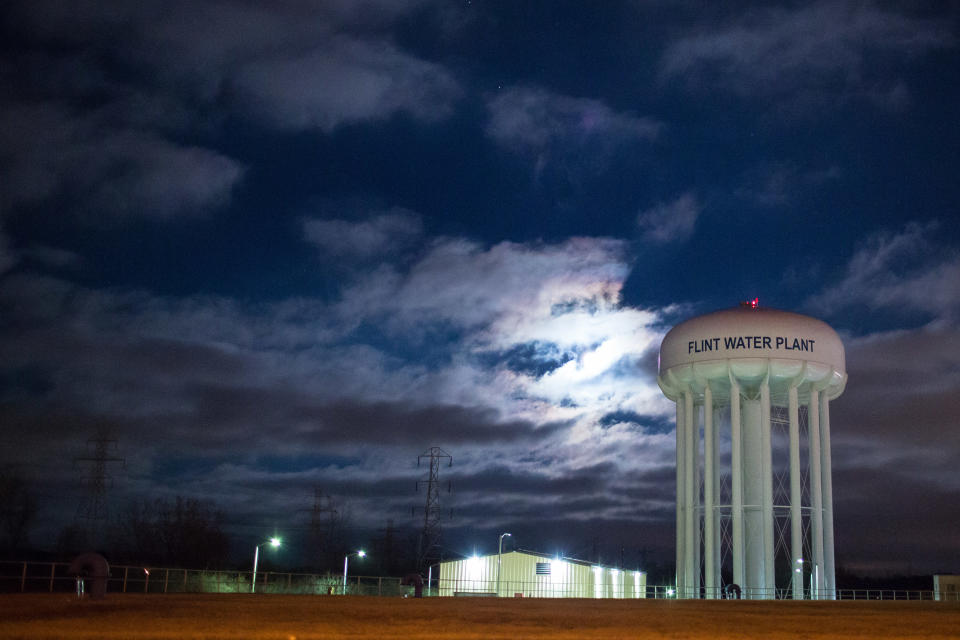Lead in Flint's water linked to decline in birth rate, study finds

The lead contamination of the Flint, Mich., water system that began in 2014 has shown up in the blood of thousands of children across the city, and public health officials are keeping a watch out for possible health and behavioral effects. A new study by two researchers points to one possible, and troubling, effect: declining fertility and poorer neonatal health.
According to the research of health economics professors Daniel Grossman of West Virginia University and David Slusky of the University of Kansas, after the city’s water source was switched to the Flint River in 2014, fertility rates among Flint residents decreased by 12 percent, while fetal death rates increased by 58 percent. (PDF)
Grossman and Slusky used vital statistics data, including detailed information on every woman who gave birth in Michigan between 2008 and 2015, to track changes in the fertility rate and birth outcomes among Flint residents compared with those in other parts of the state. In the period between April 2014, when Flint began sourcing its drinking water from the river, and September 2015, when Michigan Gov. Rick Snyder first acknowledged there was a problem with lead contamination in the water, the researchers found that the rate of pregnancies in Flint took a considerable dip, while elsewhere in Michigan — where the drinking water was unaffected — the fertility rates remained relatively stable.

To rule out the possibility that the pregnancy rate declined because the residents of Genesee County were having sex less often, Grossman and Slusky consulted the Bureau of Labor Statistics’ American Time Use Survey, which reported that sexual activity in Flint’s Genesee County actually increased in this time period. (The survey reports on a range of time uses, including “personal or private activities” including “having sex,” “making out,” “cuddling partner in bed” and “spouse gave me a massage.”)
“While this is only suggestive evidence,” they write, “it supports our conclusion that the reduction in the conception rate is not driven by a reduction in sexual activity.”
The research also found that babies born in Flint after the water supply changed were 150 grams (5.29 ounces) lighter, and gained less weight, than babies born in other parts of the state.
At least one other study found similar effects from widespread lead pollution — in Washington, D.C., from 2000 to 2003. But Grossman and Slusky admit that “the effects of lead in water on fertility and birth outcomes are not well established.”
“At first glance, this is a credible study, and I am sure people are trying to reproduce it as we speak,” Virginia Tech professor Marc Edwards, who helped expose the Flint water crisis, told Yahoo News. The study has not yet been peer reviewed but was published last month as part of the University of Kansas Economics Department’s Working Papers Series in Theoretical and Applied Economics.
“The magnitude of the effect seems higher than what I would have expected, but this is why we do science,” Edwards continued. “Our expectations are very often wrong.”
Grossman and Slusky bookend their findings with references to a draft of the Trump administration’s 2018 budget proposal, released in May, which seeks to cut more than $5 billion, or 31 percent, of funding to the Environmental Protection Agency.
“This study is of great importance as the current legislative environment includes calls for a substantial decrease in funding for the EPA which is charged with ensuring localities maintain minimum water standards,” the authors write in their conclusion. “Our results suggest that a more lax regulatory environment in the context of drinking water may have substantial unforeseen effects on maternal and infant health, including large reductions in the number of births.”

Among the specific programs at risk of elimination under Trump’s suggested slashes to the EPA are the agency’s Lead Risk-Reduction program as well as several regional offices focused on preserving water systems like the Chesapeake Bay, the Gulf of Mexico, Puget Sound, and the Great Lakes.
Even under the Obama administration, though, the EPA failed to prevent the Flint water crisis.
Before resigning ahead of congressional hearings over the water crisis in February 2016, the administrator of EPA’s Region 5, covering the Great Lakes area, Susan Hedman, admitted that she was aware of problems with Flint’s drinking water as early as April 2015. But she did not take any action to investigate Michigan’s drinking water program until November of that year.
“Since Ms. Hedman resigned, I have only positive things to say about the performance of EPA R5,” Virginia Tech’s Edwards told Yahoo News via email. “While reasonable people can differ about priorities for spending, budget cuts will most certainly not help EPA fulfill their important mission.”
Though EPA Administrator Scott Pruitt has denied plans to close specific regional offices, reports that Region 5 could be shuttered under Trump’s proposed budget have sparked backlash from a bipartisan coalition of Michigan lawmakers, including Republican Reps. Fred Upton and Mike Bishop, Rep. Dan Kildee, a Democrat from Flint, and Democratic Sen. Debbie Stabenow.

“This latest report is truly heartbreaking,” Stabenow said in a statement to Yahoo News. “This is another terrible reminder of how the water crisis has hurt residents in Flint.”
Request for comment from a member of Region 5’s media relations team was forwarded to EPA spokesman Jahan Wilcox, who was unable to obtain approval for a statement on this story by publishing time.
Grossman noted the significance of the study’s findings in light of current threats to the EPA.
“The reason we were able to do this study is that other researchers learned of the high rates of lead in the water,” he told Yahoo News. “One aspect of the proposed cuts to the EPA is to cut areas that are charged with testing water for contaminants. With fewer resources, areas may not know that their water source is contaminated, which can have serious consequences (as our current study reports).”
This January, nearly three years after the city began pumping water from the Flint River in an effort to save money, officials finally declared that the lead in the city’s drinking water had declined to below the legal limit — though many residents remained skeptical.
A total of 15 state and local officials have received criminal charges in relation to the water contamination crisis. Five, including the head of Michigan’s health department, have been indicted for involuntary manslaughter in the death of one of 11 people who died in an outbreak of Legionnaires’ disease attributed to bacterial contamination of the city’s water supply, a problem related to, although distinct from, the lead pollution.
Read more from Yahoo News:



